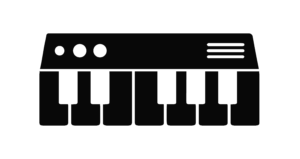Blog Search:
balance rail
The balance rail the the rail that runs underneath the centre of the key-bed. It holds each key in resting position via a pin. When a key is pressed it will pivot on the balance rail, pushing the rear of the key up to engage the action mechanism. Therefore acting as a fulcrum point. On […]
damper
A damper is a felt pad designed to deaden the sound of the string, tine, or reed. On most keyboard instruments, the damper is lifted when the key is pressed just before the hammer strikes, allowing the note to sustain. When a key is released, the damper falls and stops the vibration of the note, […]
fly
A component of the Wurlitzer piano action. Its role is to hold the hammer which strikes the reed by being pushed by the lower action (called the whip assembly). It works by the key being pressed which triggers the whip assembly which in turn pushes the fly towards the reed. On the underside of the […]
front rail
The front rail is the wooden rail at the front of the keyboard (as you are in front of it) that holds the front rail key pins. Its function is to provide a resting spot for the key when it has been pressed. A felt bushing is placed on each pin to stop the key […]
hammer
In piano terms, a hammer is the system that strikes the string, tine, or reed to generate a note. When a key is pressed, the lower action mechanism triggers the hammer to propel towards the string, tine, or reed in question. On acoustic pianos and Wurlitzers, hammers are made using compressed felt (though on a […]
hammer tips
Tips made of hardened rubber that when the key is pushes strike the string of a Clavinet. They are usually square but are sometimes rounded.
harp
In electric piano terms, the harp is the part of the action that houses the tone-bar assembly on a Rhodes, or the reeds on a Wurlitzer. It is so-called because in and of itself it is able to generate the notes needed for the instrument to work (i.e. running your hand across it like a […]
hum shield
The hum shield is an L-shaped metal frame on Wurlitzer 200 series pianos that covers the reed-bar assembly and piano action. It is designed to help eliminate buzzing and vibrations that could be transferred into the pick-ups on the reed bar. Combined with anti-vibration foam pads, it can be a very effective way of minimizing […]
key dip
Key dip is the distance the key on a piano travels between its rest position and the position when the key is pressed. This is usually 10mm or 3/8 of an inch. It is adjusted by adding or removing paper punchings to the front rail of the key. A shallower key dip can lead to […]
key height
Key height is the setting of the correct height of the white and black keys for the entire keyboard. It is adjusted by adding or removing paper punchings to the balance rail of the key. Even key height is essential to even regulation and good appearance of a piano. Key height adjustments also affect key […]
key levelling
The process of regulating the white and black keys of a keyboard. It usually involves adjusting the side-play, squaring, and spacing of keys, and setting the key height and key dip.
pick-up
A pick-up is a component that converts sound vibrations into electrical energy, essential for the pre-amplification of the piano. On a Rhodes the tine vibrates next to a coiled copper winding around a small magnet, effectively an electromagnet, that ‘picks up’ the sound of the tine. On a Wurlitzer, the pick-up is electro-static, meaning the […]
reed
A reed is a flat metal strip on a Wurlitzer piano that is struck by a hammer to generate a tone. On each reed is a pyramid shaped section of solder which allows the reed to be tuned. The heavier the reed, the lower it is in pitch, and vice-versa. It is attached to the […]
side play
Side play is the side to side movement of a key that occurs when the key bushings are not tight enough. This leads to a rocking which can make the key difficult to control or bump into its neighbouring keys. A key that has the correct amount of side play will barely move side to […]
strings
A length of wire that when plucked, struck or strummed vibrates to create a tone. Can be tuned to adjust the pitch of the note. On a Clavinet the strings are a similar thickness to guitar strings, and are sounded by the hammer tip connected to the keyboard being pressed against the string. On an […]
sustain pedal
the sustain pedal is a pedal pressed with the foot that lifts all the dampers on a piano allowing every note to ring or sustain. It allows for smoother passages in musical phrases, as well as adding colour and expression into the music being played. On an acoustic piano, the susatin is the right-most pedal. […]
tine
A strong length of steel wire in a Rhodes piano that is struck by the hammer to make a tone. Part of the tone-bar assembly, which consists of a tuning fork-like arrangement between the tine and the tone bar. On the tine is a metal coil which can be adjusted to fine tune that note.

